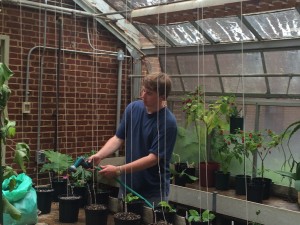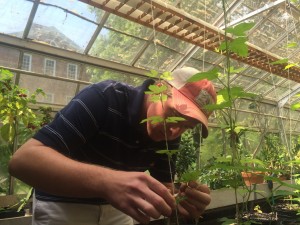by Chris Hawk ’16
During the summer of 2015, I have been studying strategies to detect fungal pathogens of Humulus lupulus, commonly referred to as hops. The hops crops of Virginia have been threatened in recent years by a number of microbial pests, making studies of the ways in which hops and microbes interact both scientifically and commercially interesting. In order to do so, I have been growing live tissue in our greenhouse, by means of steam propagation and the transplanting of rhizomes from live tissue. Currently, I have a few varieties and species of Hops in the greenhouse, including Cascade, Mt. Hood, Willamette, an unknown variety found locally, and Humulus japonicas—an invasive hop.
Using the greenhouse to grow these plants has, for the most part, kept the fungal pathogens Pseudoperonospora humuli (downy mildew) and Podosphaera macularis (powdery mildew) from infecting the plants. However, I have been purposefully infecting the hops with the two fungal pathogens to determine how quickly the plants become infected before they show phenotypic signs of infection. Understanding how these fungal pathogens best develop and spread on hops will allow me to better understand how they can be effectively controlled.
This work will be a central part of Hampden-Sydney’s introductory biology lab course in the Fall of 2015. Here, several students will build on the results I find to try and better understand how hops can be most effectively grown and managed in Virginia.


